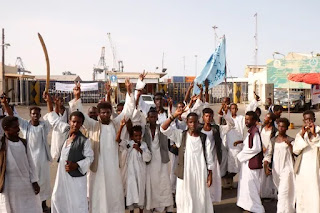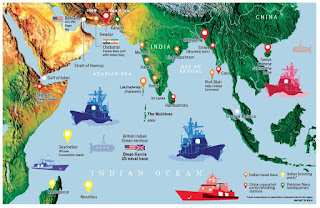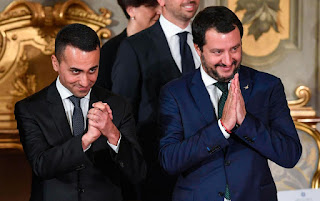High Tensions in Sudan after New Protests
Photo source: Al Jazeera
By Naveed Qazi | Editor, Globe Upfront
By Naveed Qazi | Editor, Globe Upfront
Throngs of protesters marched in October 2021 in Khartoum and other major cities, to voice their support for a civilian rule. To some estimates, participants numbered in thousands. Many businesses in central Khartoum had been closed in anticipation of more protests, and there was an extensive police presence.
It is Sudan’s biggest political crises in
its two year old transition. The military had dissolved the transitional government, and also arrested the prime minister Hamdok and some other civilian leaders. It made African Union suspend Sudan's membership.
Before the coup, Sudanese graveled about the power sharing
agreement, drafted as the Sovereign Council, between civilian groups and
military, since toppling of long standing President Omar al Bashir in 2019.
There had been another failed coup attempt in September 2019 attributed to
forces loyal to Bashir. Most of the involved officers, however, were arrested.
Military leaders, on the other hand, had been demanding reforms to the Forces of Freedom and Change (FFC) coalition, the civilian umbrella and the replacement of the cabinet. Civilian leaders, however, have accused them of aiming for a power grab, but military insists that they are committed to next elections in 2023.
Pro-civilian protesters have been calling for the preservation of the democratic transition, and the values of the revolution that were gained after the 2019 uprising. There is a strong support of U.S for Sudan’s democratic transition as well.
These protests took place on the anniversary of the country's 1964 October Revolution, and were preceded by days of smaller neighbourhood protests. To counter this, there also has been a rival sit-in that has been orchestrated by senior figures in the security forces, Bashir sympathisers and other counter-revolutionaries.
Volker Perthes, UN special representative to Sudan, stressed
‘the need to maintain the constitutional partnership between the military and
civilian component.’ Perthes even urged for a return to dialogue and to build
on achievements of the transitional period.
Popular support for the government, which was led by
Hamdok, who was picked in 2019 by a once-united FFC, had also waned over a
tough raft of economic reforms that took a toll on ordinary Sudanese. Delays in
delivering justice to the families of those killed under Bashir, and even
during the 2019 protests following his ouster, has left Hamdok vulnerable to
criticism.
And since mid-September 2019, the government
has been criticised for its handling of anti-government protests in the east,
resulting in a blockade of Sudan’s key maritime trade hub of Port Sudan by Beja
tribes, triggering shortages nationwide. There were dozens of containers that
were left untouched, and roads leading to Khartoum were cut. The port is
pivotal for Sudan, as country’s sixty per-cent of trade passes through it, with
an average of twelve hundred containers. It is due to this reason why South
Darfur was left without adequate supply of bread, due to poor wheat supply. Other smaller ports in
the east, including Osman Digna in Suakin city, have also been blocked. With
the result, some thirty three thousand port workers and others who work in
customs and shipping offices have had no income since the closure.
In the October 2020 peace deal between the rebels
and government, it is believed by dwellers of eastern Sudan that they have been
not represented well. Similar protests happened in the past, although they were
on a smaller scale. Several hundred of truck drivers have also joined in the
protests. Hence, the protests in the east were the starting point for the wave
of unrest in the country.
According to Al Jazeera journalist, Hiba
Morgan, the 2020 deal is ‘not the representative
and does not address the root causes of marginalisation’ and ‘underdevelopment
in the eastern region.’
There have been futile attempts by the
government to save Sudan from economic collapse, by embarking on IMF backed
economic reforms, including scrapping diesel and petrol subsidies, as well as declaring a
managed float of the Sudanese pound to stem a rampant black market. Sudan is still reeling from a triple-digit inflation rate
which only slightly eased in mid-2021.
It was in September 2021 when tensions even
escalated between Sudan and Ethiopia over disputed border areas of fertile
farmlands in al-Fashqa. Sudan military had said that it had thwarted an attempted incursion by Ethiopian forces in the border area
between the two countries. The Ethiopian forces were made to retreat from the
Umm Barakit area.




Comments
Post a Comment
Advice from the Editor: Please refrain from slander, defamation or any kind of libel in the comments section.